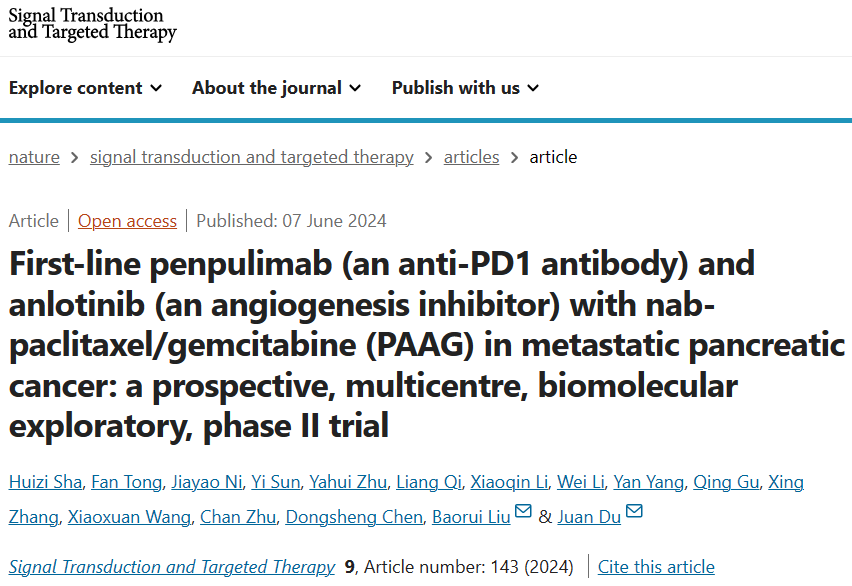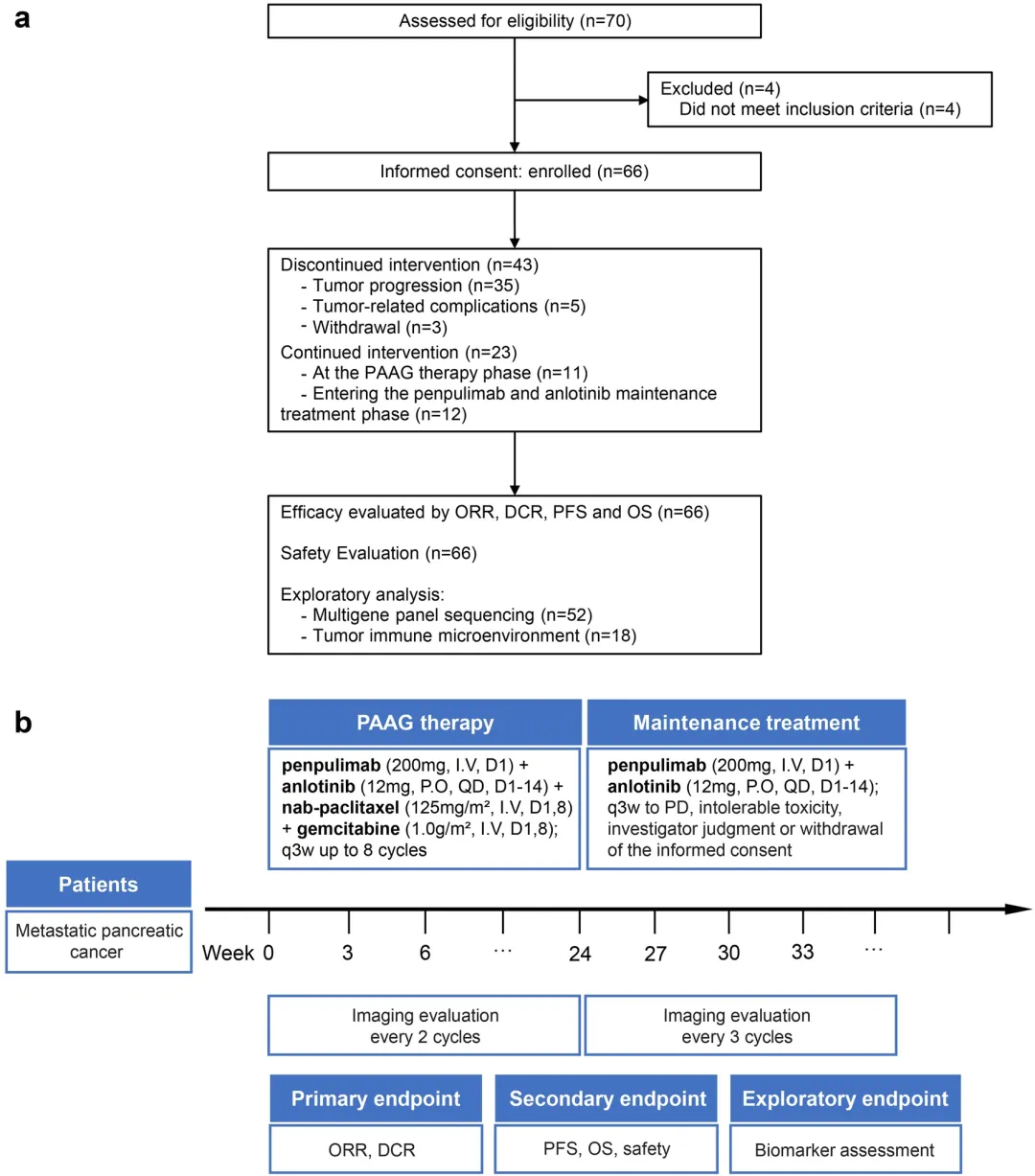胰腺癌是消化系统常见的恶性肿瘤之一,发病人数逐年增多,到2030年可能成为全球第二大癌症杀手[1]。近日,中国生物制药(1177.HK)下属企业正大天晴的1类创新药安罗替尼和派安普利单抗联合白蛋白结合型紫杉醇与吉西他滨一线治疗转移性胰腺癌的一项研究在线发表于国际知名期刊Signal Transduction and Targeted Therapy(2022年IF=39.3),通讯作者为南京鼓楼医院刘宝瑞教授和杜娟教授。该研究有望为这部分患者带来新的治疗选择。

图1 图片来源于STTT官网
目前,晚期转移性胰腺癌的主要治疗手段是全身化疗,但效果有限,总生存期通常不超过一年[2,3]。临床发现,化疗联合免疫方案可将ORR提升至约50%[4,5],但如何将ORR获益转化为OS和PFS改善仍面临较多挑战。
研究显示,抗血管生成药物可以改变肿瘤微环境,联合免疫发挥协同增效的作用[6]。既往研究中,安罗替尼在单独或联合治疗中均表现出对胰腺癌的有效性[7-9]。本研究是一项针对转移性胰腺癌患者的前瞻性、多中心、单臂、II期研究,采用PAAG(派安普利单抗、安罗替尼、白蛋白结合型紫杉醇/吉西他滨)一线治疗方案。

图2 PAAG研究流程图
a. 患者处置流程;b. 治疗时间线
图片来源:正大制药订阅号
研究结果显示,66例患者疗效可评估,最长治疗期近18个月。其中有33例患者达到了PR,客观缓解率(ORR)为50%,疾病控制率(DCR)为95.5%,中位无进展生存期(mPFS)对比目前临床一线含铂类方案化疗显著延长至8.8个月,中位总生存期(mOS)为13.7个月。此外,本研究经分子生物学分析,患者基线时低血清CA724水平、高T细胞募集评分(TCRS)、低Th17细胞募集评分和高NK CD56dim细胞评分可能是预测疗效更佳的潜在生物标志物[10,11]。
安罗替尼作为正大天晴在肿瘤领域的拳头产品,自2018年上市以来,已先后获批6大适应症,服务患者超90万人,显示了广泛的应用前景。此外,安罗替尼还有多个项目处于在研阶段,布局广泛,以期满足更多领域临床治疗需求,
派安普利单抗的第三个适应症于今年5月获批,其作为差异化PD-1单抗,在临床中被广泛用于治疗非小细胞肺癌、霍奇金淋巴瘤、鼻咽癌。
除本研究外,安罗替尼联合派安普利单抗一线治疗肝细胞癌的适应症即将申报上市。在最近结束的ASCO年会上,公司还公布了安罗替尼联合派安普利单抗用于治疗宫颈癌和乳腺癌的多个研究结果。未来,中国生物制药将继续以未被满足的临床需求为导向,持续创新研发,为更多的恶性肿瘤患者带来临床希望。
参考文献:
1. Kamisawa, T., et al., Pancreatic cancer. The Lancet, 2016. 388(10039): p. 73-85.
2. Von Hoff, D.D., et al., Increased survival in pancreatic cancer with nab-paclitaxel plus gemcitabine. New England Journal of Medicine, 2013. 369(18): p. 1691-1703.
3. Gourgou-Bourgade, S., et al., Impact of FOLFIRINOX compared with gemcitabine on quality of life in patients with metastatic pancreatic cancer: results from the PRODIGE 4/ACCORD 11 randomized trial. J Clin Oncol, 2013. 31(1): p. 23-29.
4. Fu, Q., et al., Sintilimab plus modified FOLFIRINOX in metastatic or recurrent pancreatic cancer: the randomized phase ii cispd3 trial. Annals of Surgical Oncology, 2023. 30(8): p. 5071-5080.
5. Padrón, L.J., et al., Sotigalimab and/or nivolumab with chemotherapy in first-line metastatic pancreatic cancer: clinical and immunologic analyses from the randomized phase 2 PRINCE trial. Nature medicine, 2022. 28(6): p. 1167-1177.
6. Khan, K.A. and R.S. Kerbel, Improving immunotherapy outcomes with anti-angiogenic treatments and vice versa. Nature Reviews Clinical Oncology, 2018. 15(5): p. 310-324.
7. Zhan, G., et al., A real-world study of anlotinib combined with GS regimen as first-line treatment for advanced pancreatic cancer. Frontiers in Endocrinology, 2023. 14: p. 1110624.
8. Mafei, K., X. Shengyuan, and S. Jieqiong, Pembrolizumab enhances the anti-pancreatic cancer activity of anlotinib. Asian J Surg, 2022. 45(3): p. 881-882.
9. Zhang, X., et al., Multi-Omics Analysis of Anlotinib in Pancreatic Cancer and Development of an Anlotinib-Related Prognostic Signature. Front Cell Dev Biol, 2021. 9: p. 649265.
10. 《中国临床肿瘤学会(CSCO)胰腺癌诊疗指南2024》
11. Baorui Liu&Juan Du, First-line penpulimab (an anti-PD1 antibody) and anlotinib (an angiogenesis inhibitor) with nab-paclitaxel/gemcitabine (PAAG) in metastatic pancreatic cancer: a prospective, multicentre, biomolecular exploratory, phase II trial. Signal Transduction and Targeted Therapy. Published:07 June 2024.



合作咨询
![]() 肖女士
肖女士
![]() 021-33392297
021-33392297
![]() Kelly.Xiao@imsinoexpo.com
Kelly.Xiao@imsinoexpo.com
 2006-2025 上海博华国际展览有限公司版权所有(保留一切权利)
沪ICP备05034851号-57
2006-2025 上海博华国际展览有限公司版权所有(保留一切权利)
沪ICP备05034851号-57